Red Hat Deep Dive Sessions SELinux Shawn D. Wells, RHCE EMail: swells@redhat.com Solutions Architect @ Red Hat 1
Slide 1

Slide 2

Agenda 1) Why do we need SELinux? What are the principal concepts? 2) SELinux Details Type Enforcement What are the available policies? What’s a policy actually made of? How do I {add, change} a policy? What’s the associated overhead? 3) Usage User Perspective Admin Perspective 4) Scenarios Fixing the RHT Corporate VPN “update” 2
Slide 3
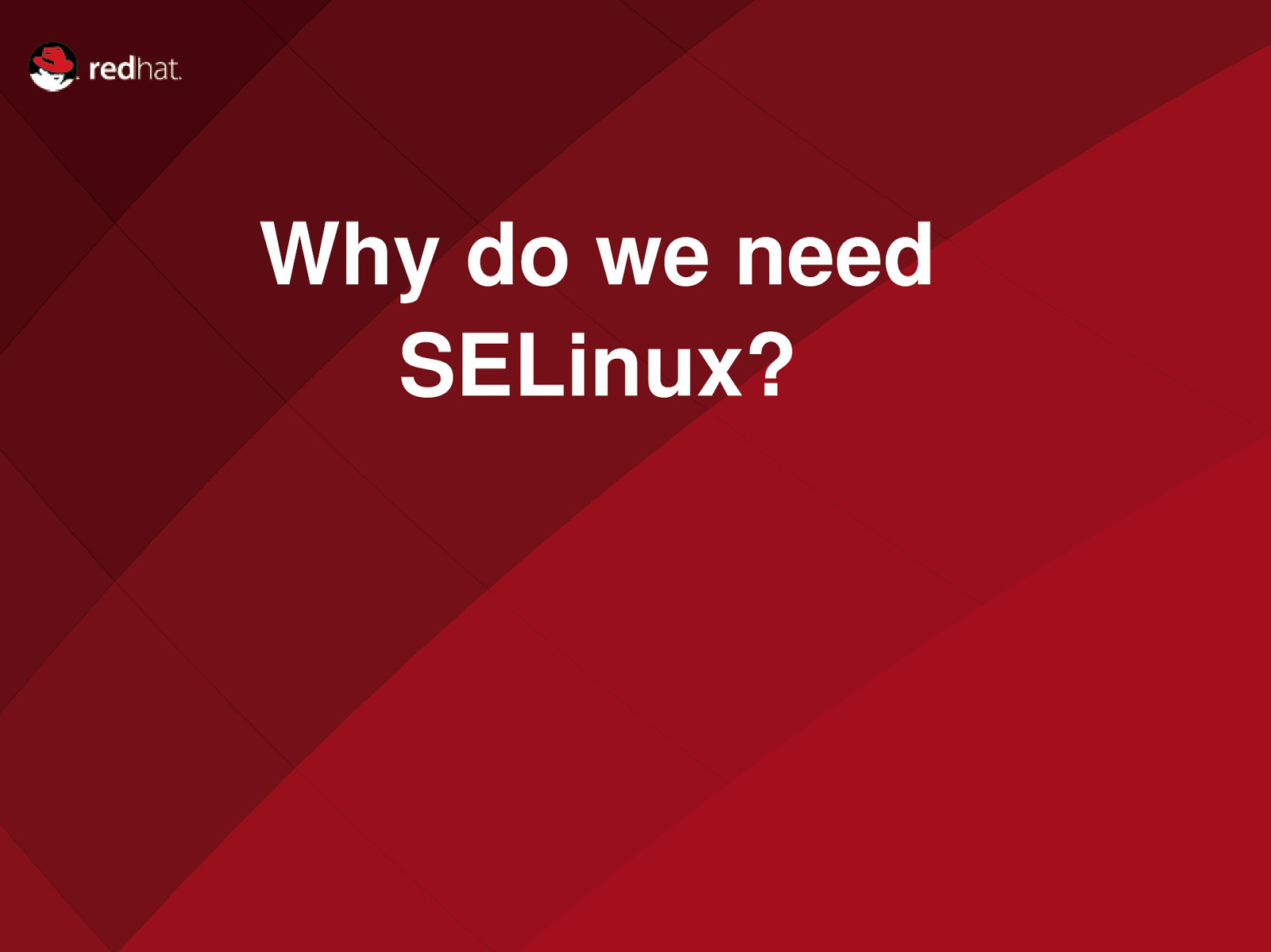
Name of Presentation Why do we need Red Hat Presenter SELinux?
Slide 4

Linux Access Control Problems 1) Access is based off users’ access Example: Firefox can read SSH keys # ps -x | grep firefox shawn 21375 1 35 11:38 ? 00:00:01 firefox-bin # ls -l id_rsa -rw———- 1 shawn shawn 1743 2008-08-10 id_rsa Fundamental Problem: Security properties not specific enough. Kernel can’t distinguish applications from users. 4
Slide 5

Linux Access Control Problems 2) Processes can change security properties Example: Mail files are readable only by me….. but Thunderbird could make them world readable Fundamental Problems: Standard access control is discretionary Includes concept of “resource ownership” Processes can escape security policy 5
Slide 6

Linux Access Control Problems 3) Only two privilege levels: User & root Example: Apache gets hacked, allowing remote access to root. Entire system is compromised. Fundamental Problems: Simplistic security policy No way to enforce least-privilege 6
Slide 7

SELinux: Building Security Openly NSA Develops SELinux Integrated into Linux Kernel Enabled By DEFAULT In RHEL Integrated into Open Source Project Customers, NSA, Community, and Red Hat continue evolution 7
Slide 8

Red Hat Security Certifications NIAP/Common Criteria: The most evaluated operating system platform ● Red Hat Enterprise Linux 2.1 – EAL 2 (Completed: February 2004) ● Red Hat Enterprise Linux 3 EAL 3+/CAPP (Completed: August 2004) ● Red Hat Enterprise Linux 4 EAL 4+/CAPP (Completed: February 2006) ● Red Hat Enterprise Linux 5 EAL4+/CAPP/LSPP/RBAC (Completed: June 2007) DII-COE ● Red Hat Enterprise Linux 3 (Self-Certification Completed: October 2004) ● Red Hat Enterprise Linux: First Linux platform certified by DISA DCID 6/3 ● Currently PL3/PL4: ask about kickstarts. ● Often a component in PL5 systems DISA SRRs / STIGs ● Ask about kickstarts. FIPS 140-2 ● Red Hat / NSS Cryptography Libraries certified Level 2 8
Slide 9
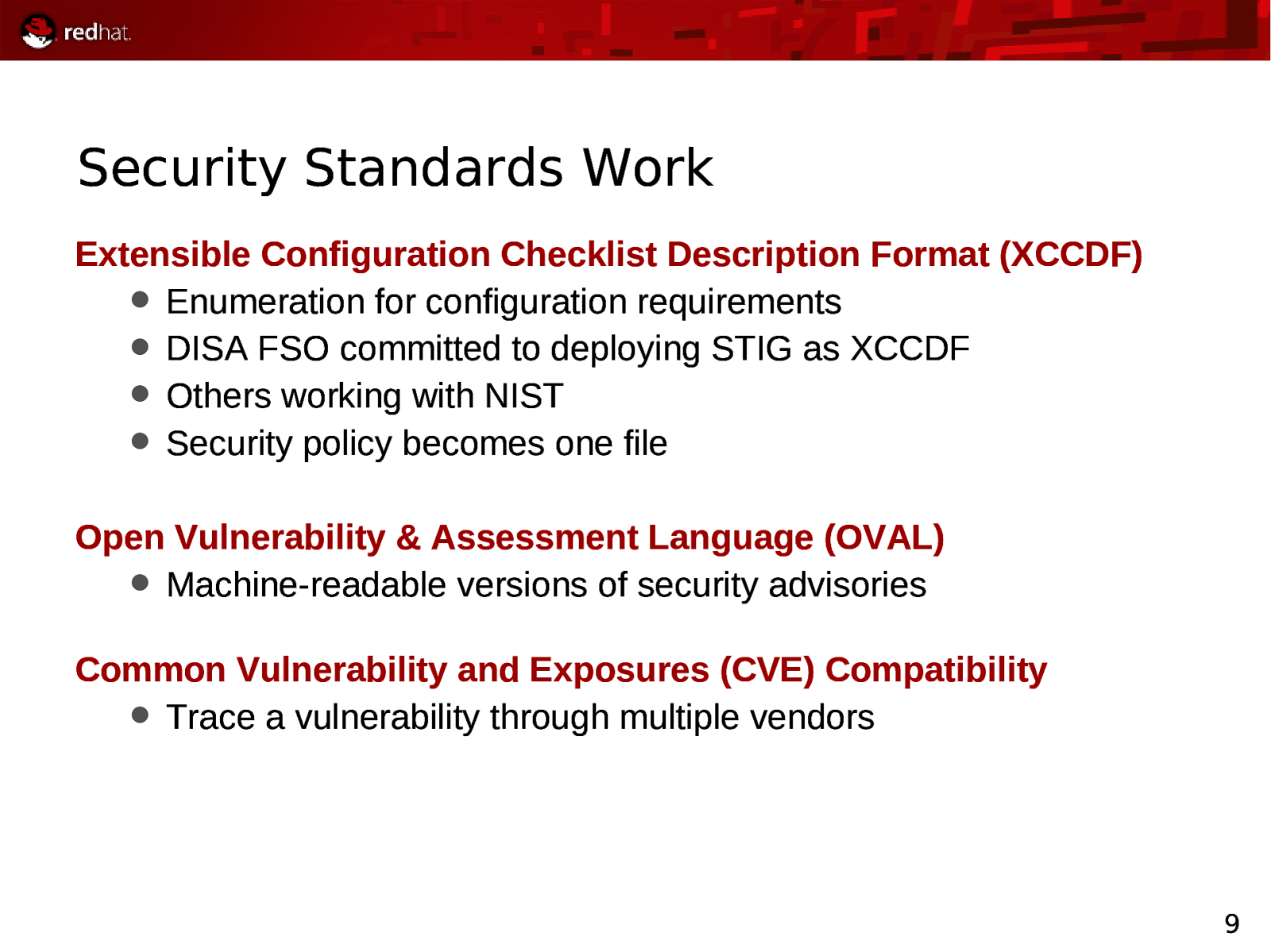
Security Standards Work Extensible Configuration Checklist Description Format (XCCDF) Enumeration for configuration requirements DISA FSO committed to deploying STIG as XCCDF Others working with NIST Security policy becomes one file Open Vulnerability & Assessment Language (OVAL) Machine-readable versions of security advisories Common Vulnerability and Exposures (CVE) Compatibility Trace a vulnerability through multiple vendors 9
Slide 10

Name of Presentation How’s it work? Red Hat Presenter
Slide 11

Linux Access Control Introduction Linux access control involves the kernel controling Processes (running programs), which try to access… Resources (files, directories, sockets, etc) For example: Apache (process) can read web files But not the /etc/shadow file (resource) Traditional methods do not clearly separate the privileges of users and applications acting on the users behalf, increasing the damage that can be caused by application exploits. So, how should these decisions be made? 11
Slide 12
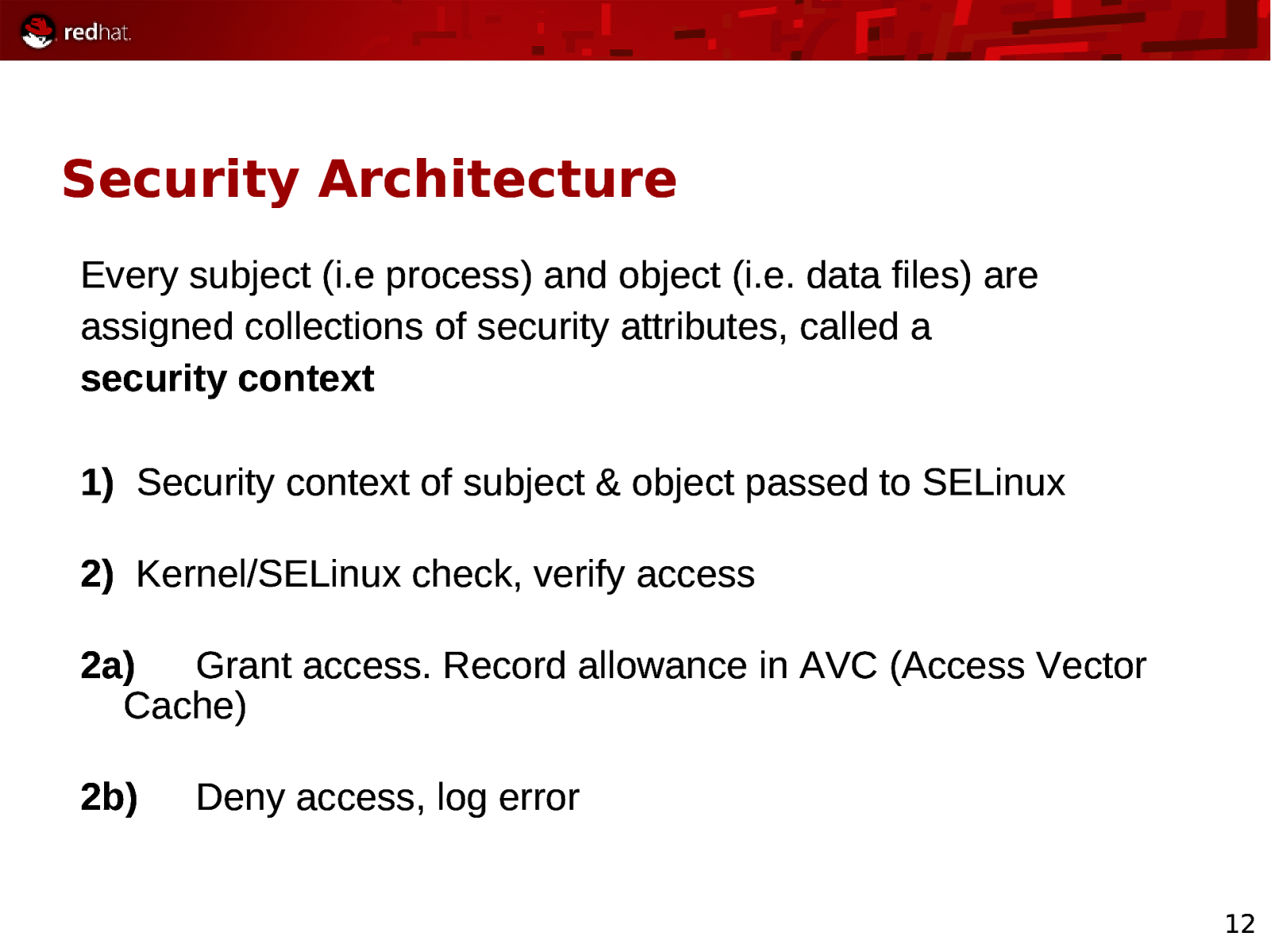
Security Architecture Every subject (i.e process) and object (i.e. data files) are assigned collections of security attributes, called a security context 1) Security context of subject & object passed to SELinux 2) Kernel/SELinux check, verify access 2a) Grant access. Record allowance in AVC (Access Vector Cache) 2b) Deny access, log error 12
Slide 13

Security Architecture Or in picture view… 13
Slide 14

Role Based Access Control (RBAC) “root” really isn’t “root” i.e: root_u:WebServerAdmin_r:SysAdmin_t root_u:OracleDBAdmin_r:SysAdmin_t 14
Slide 15

Name of Presentation SELinux Details Red Hat Presenter
Slide 16

Type Enforcement ● ● ● ● ● SELinux implements the MAC model through type enforcement. In RHEL5, SELinux also provides RBAC and Bell-LaPadula (MLS), but it uses type enforcement to implement them. Type Enforcement involves defining a type for every subject, that is, process, and object on the system. Permissions are checked between the source type and the target type for each access. Objects include (but are not limited to): ● Network Sockets ● Shared Memory Segments ● Files ● Processes ● etc. 16
Slide 17

SELinux Contexts root:object r:sysadm home t:s0:c0 ● ● ● ● ● ● The above is an SELinux context user_t role_t file_t Sensitivity category 17
Slide 18

SELinux Contexts 18
Slide 19
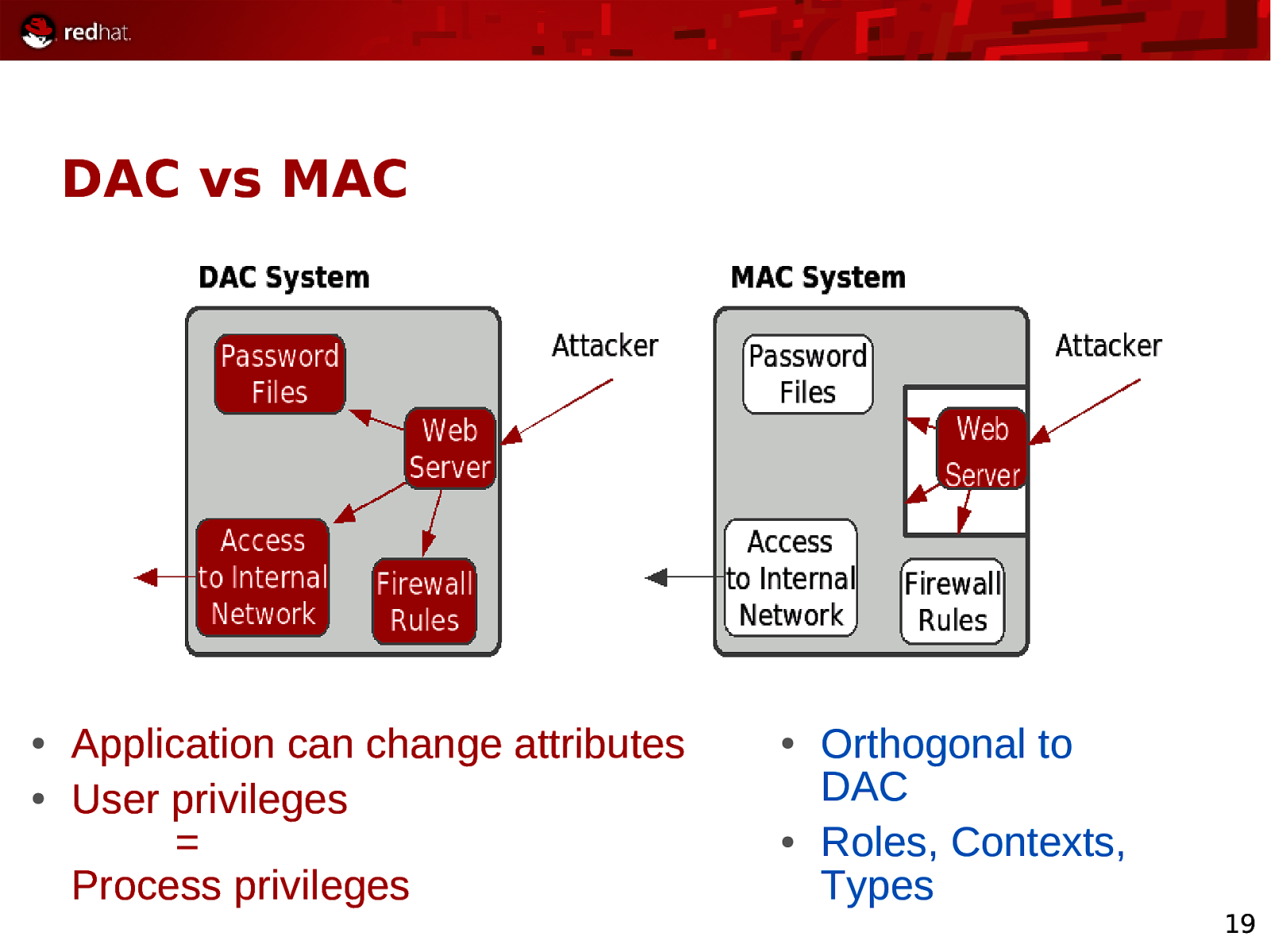
DAC vs MAC ● ● Application can change attributes User privileges = Process privileges ● ● Orthogonal to DAC Roles, Contexts, Types 19
Slide 20
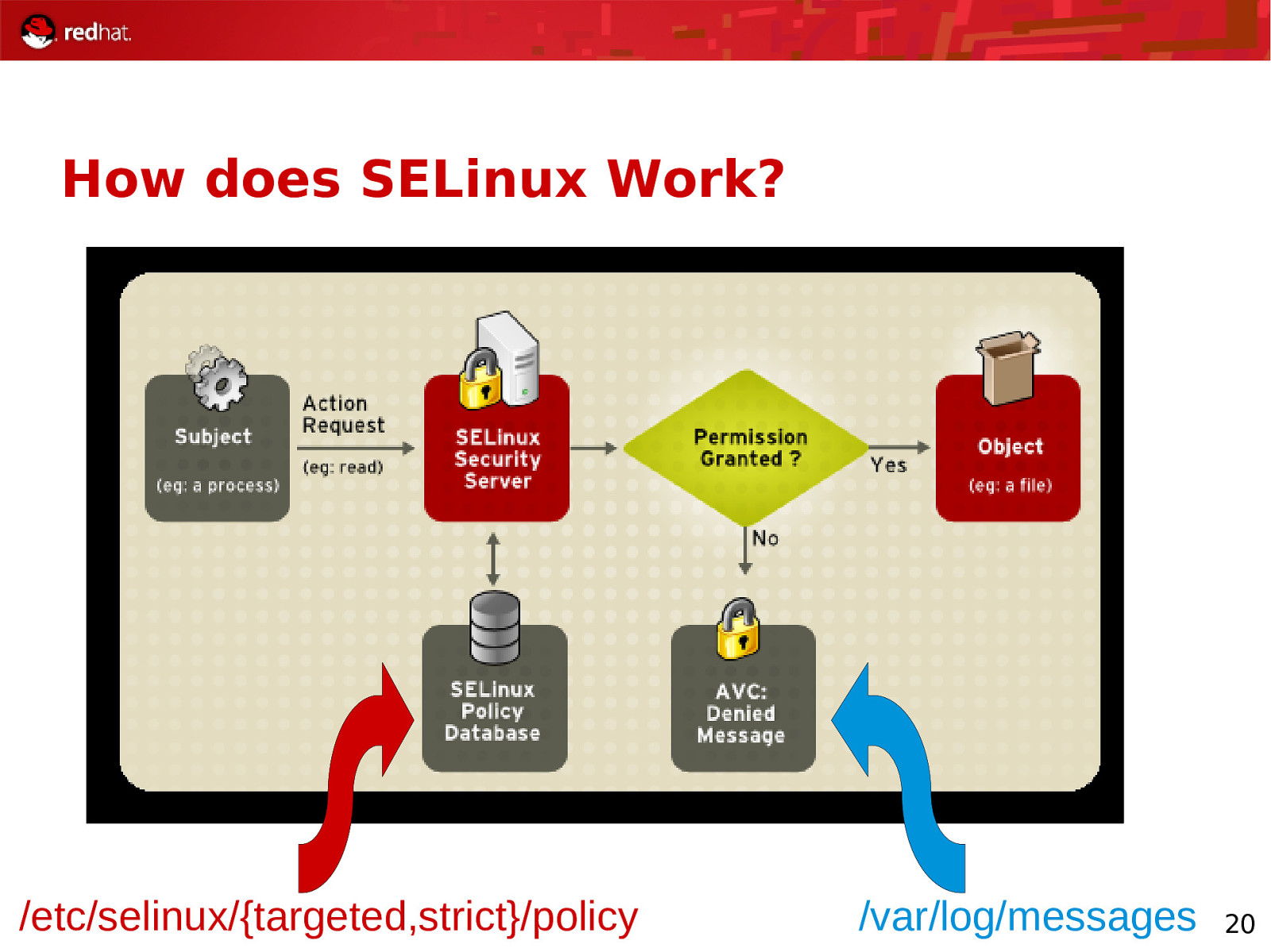
How does SELinux Work? /etc/selinux/{targeted,strict}/policy /var/log/messages 20
Slide 21
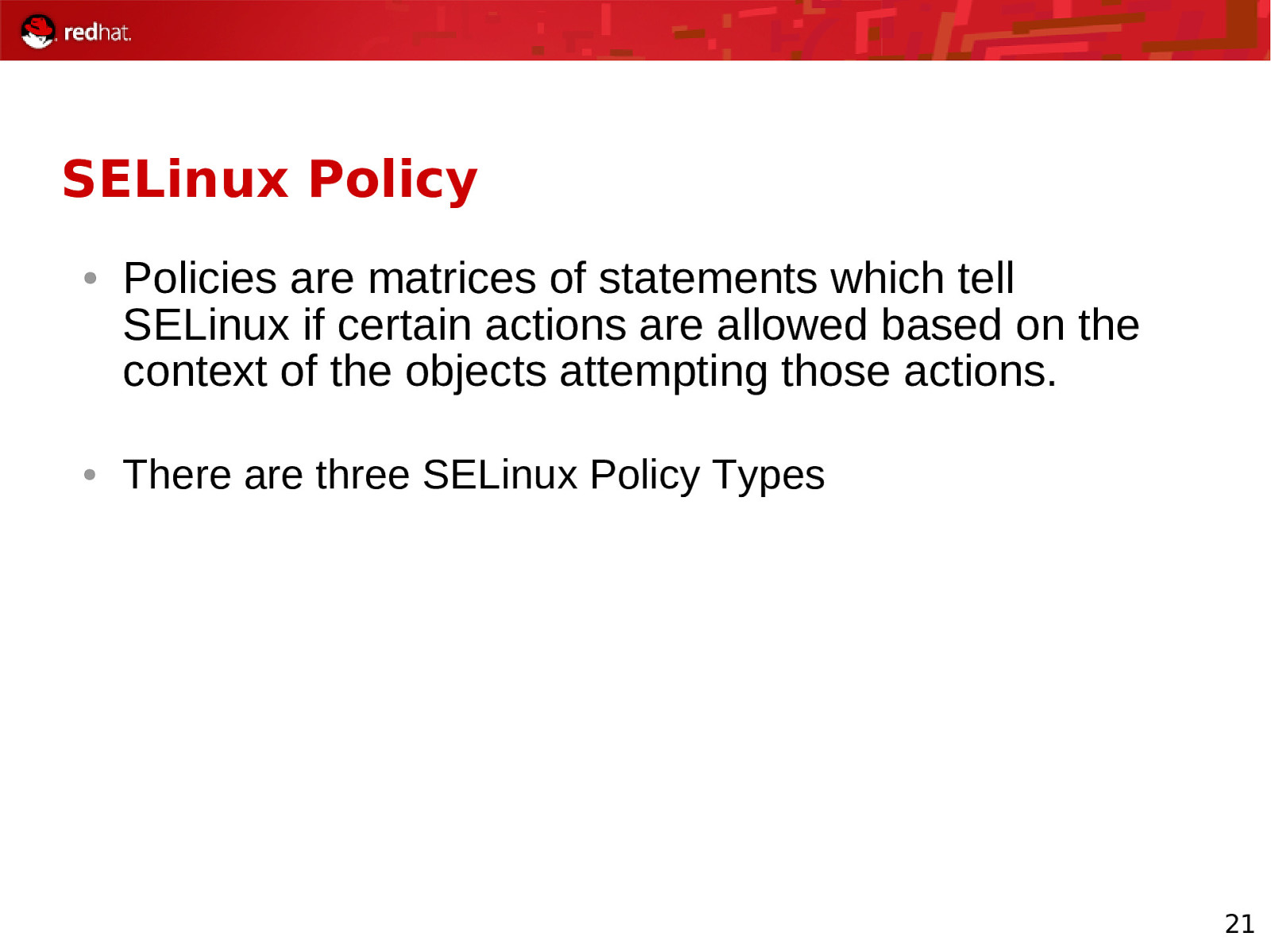
SELinux Policy ● ● Policies are matrices of statements which tell SELinux if certain actions are allowed based on the context of the objects attempting those actions. There are three SELinux Policy Types 21
Slide 22

The Three SELinux Policy Types 1) Targeted Policy Default policy in RHEL5. Supported by HelpDesk. Targets specific applications to lock down. Allows all other applications to run in the unconfined domain (unconfined_t) Applications running in the unconfined domain run as if SELinux were disabled 22
Slide 23

The Three SELinux Policy Types 2) Strict Policy Denies access to everything by default Complete protection for all processes on the system Requires that policies be written for all applications, often requires customization Strict is type enforcement with added types for users (e.g. user_t and user_firefox_t). Not enabled by Red Hat as default 23
Slide 24

The Three SELinux Policy Types 3) Multi-Level Security (MLS) Focuses on confidentiality (i.e. separation of multiple classifications of data) Ability to manage {processes, users} with varying levels of access. (i.e. “the need to know”) Uses category & sensitivity levels 24
Slide 25
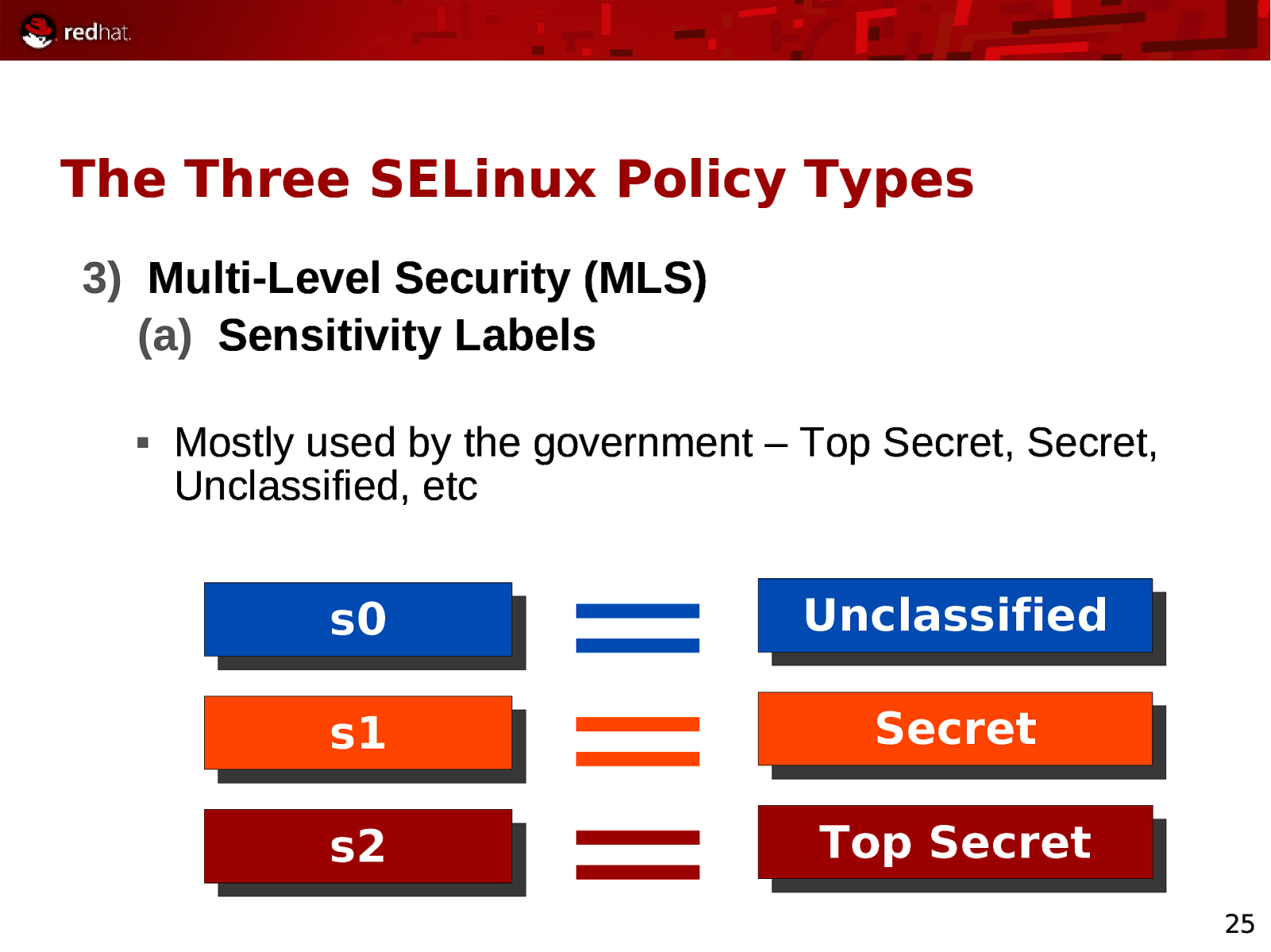
The Three SELinux Policy Types 3) Multi-Level Security (MLS) (a) Sensitivity Labels Mostly used by the government – Top Secret, Secret, Unclassified, etc s0 Unclassified s1 Secret s2 Top Secret 25
Slide 26
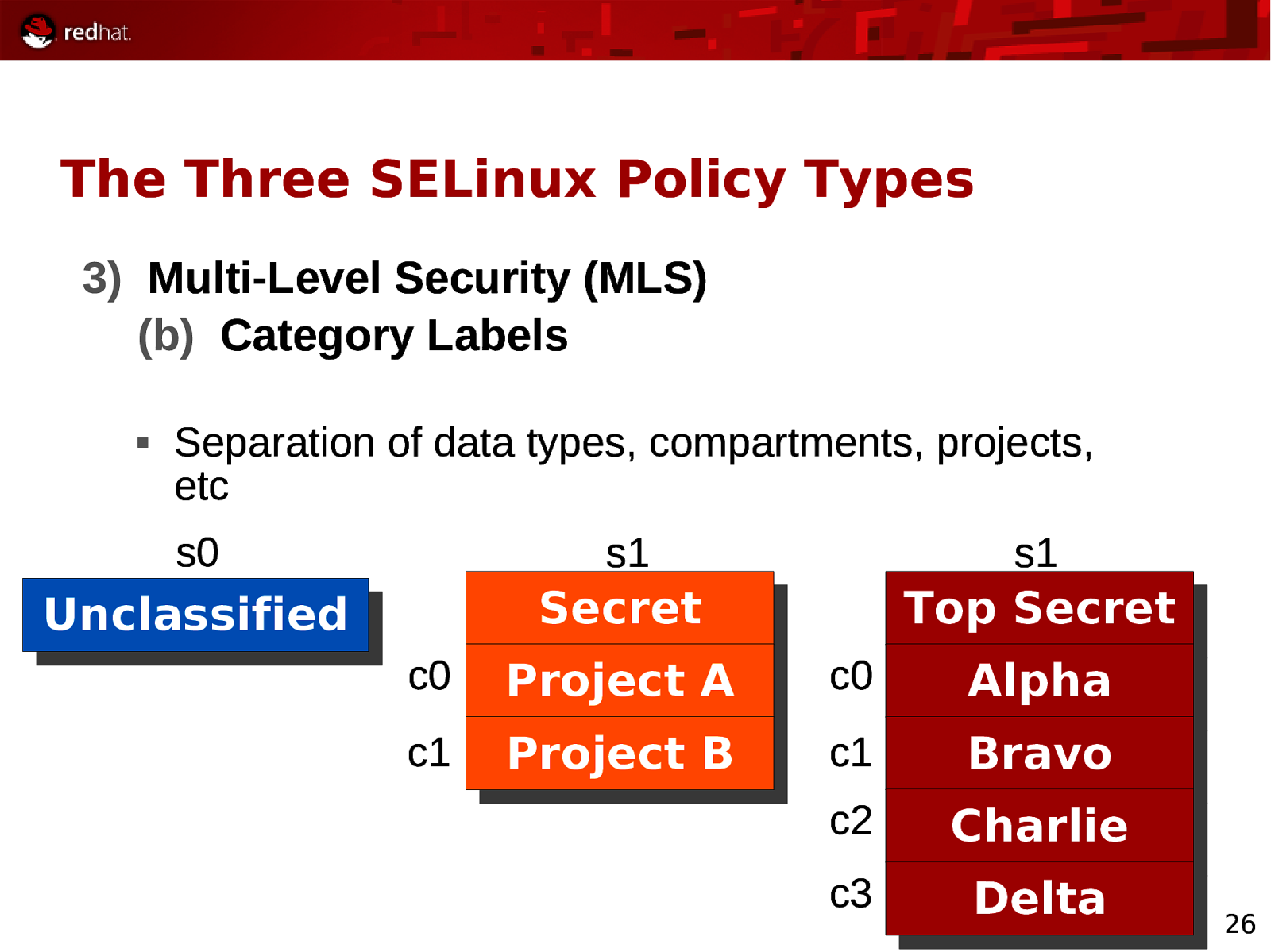
The Three SELinux Policy Types 3) Multi-Level Security (MLS) (b) Category Labels Separation of data types, compartments, projects, etc s0 s1 s1 Unclassified Secret Top Secret c0 Project A c0 Alpha c1 Project B c1 Bravo c2 Charlie c3 Delta 26
Slide 27

The Three SELinux Policy Types 3) Multi-Level Security (MLS) (b) Polyinstantiation & pam_namespace The pam_namespace PAM module sets up a private namespace for a session with polyinstantiated directories A polyinstantiated directory provides a different instance of itself based on user name, or when using SELinux, user name, security context or both 27
Slide 28

The Three SELinux Policy Types 3) Multi-Level Security (MLS) (b) Polyinstantiation & pam_namespace # id Z staff_u:WebServer_Admin_r:WebServer_Admin_t:s0:c0 # ls l /data secretfile1 secretfile 2 # id Z staff_u:WebServer_Admin_r:WebServer_Admin_t:s1:c0 # ls l /data secretfile1 secretfile 2 topsecretfile1 28
Slide 29

The Three SELinux Policy Types Multi-Level Security (MLS) & Common Criteria The Common Criteria (CC) is an international security standard against which systems are evaluated. Many government customers require CC evaluated systems. Red Hat Enterprise Linux 5 meets EAL4+ with RBAC/LSPP/CAPP endorcements 29
Slide 30

What’s the Performance Overhead? 30
Slide 31

What’s the Performance Overhead? 31
Slide 32
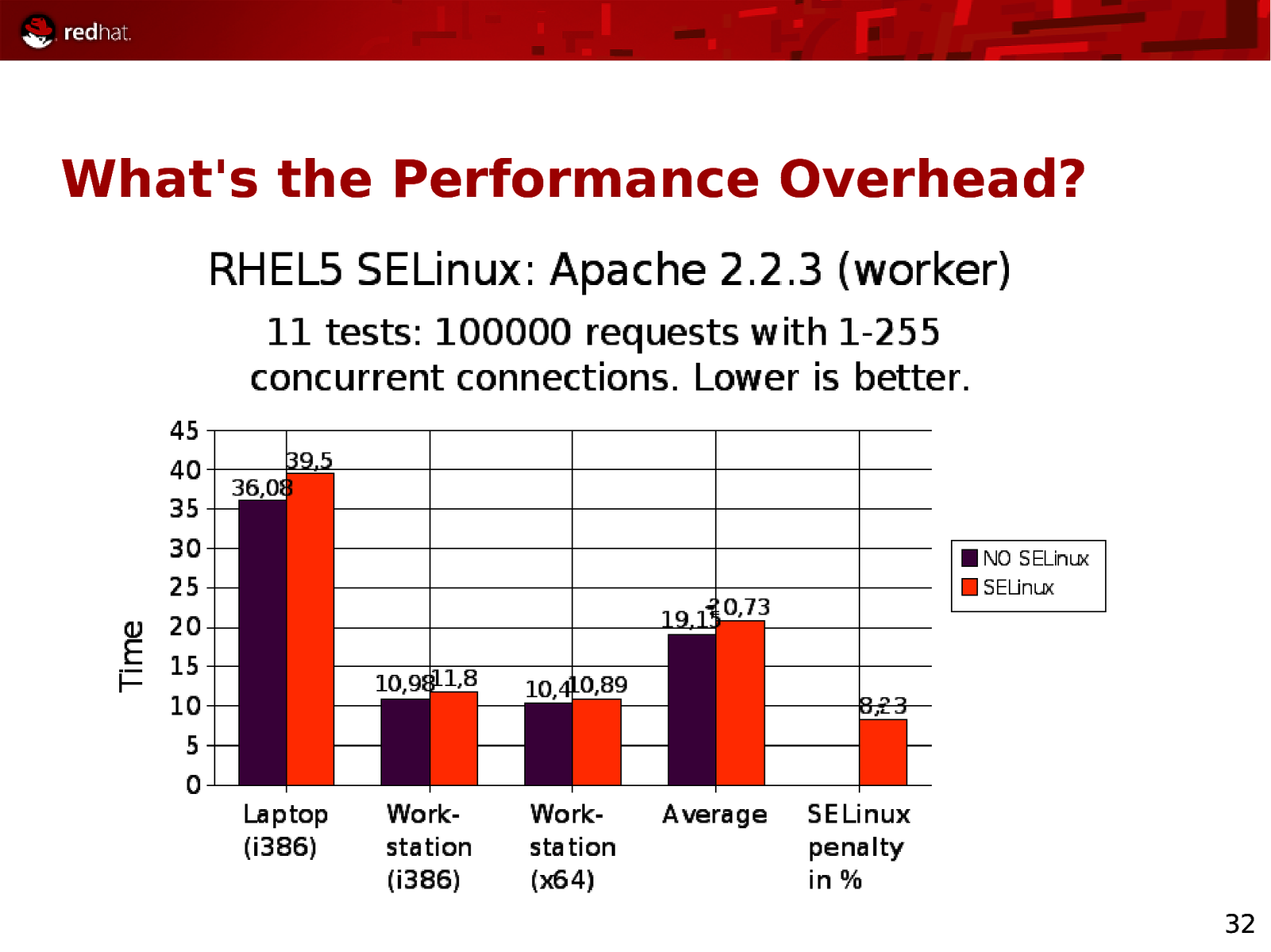
What’s the Performance Overhead? 32
Slide 33
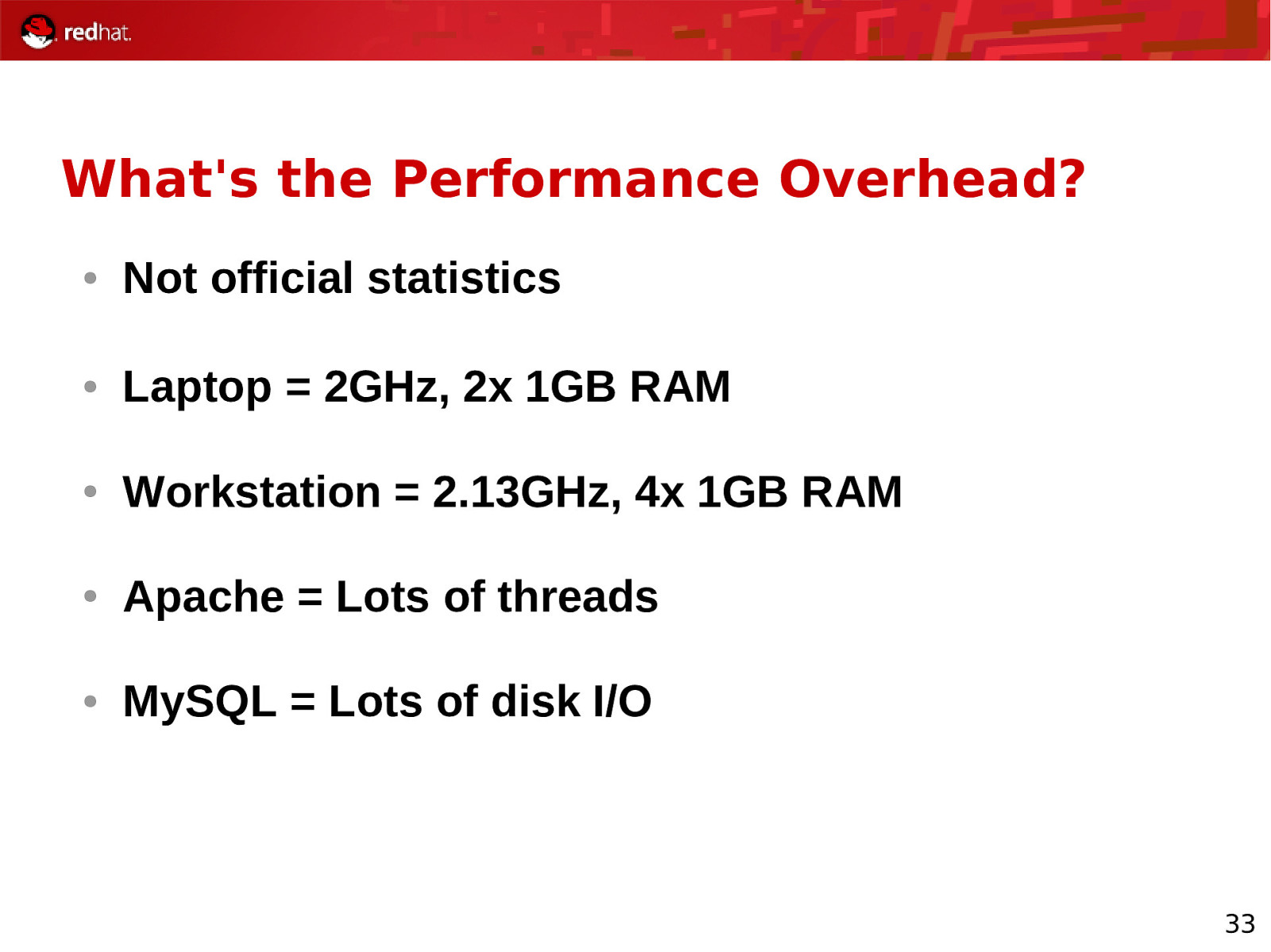
What’s the Performance Overhead? ● Not official statistics ● Laptop = 2GHz, 2x 1GB RAM ● Workstation = 2.13GHz, 4x 1GB RAM ● Apache = Lots of threads ● MySQL = Lots of disk I/O 33
Slide 34

Name of Presentation SELinux Usage Red Hat Presenter (GUI & console)
Slide 35

End-User Perspective ● sealert Notifications 35
Slide 36

End-User Perspective ● sealert Browser 36
Slide 37

System Administrator Perspective ● sealert + EMail Notifications 37
Slide 38

System Administrator Perspective ● system-config-selinux 38
Slide 39

System Administrator Perspective ● sediffx 39
Slide 40

System Administrator Perspective ● apol 40
Slide 41

Name of Presentation SELinux Usage Red Hat Presenter (Hints & Tips)
Slide 42

System Administrator Perspective ● semanage Configure elements of SELinux policy without modification/recompilation of policy sources … . aka on the fly Example: Dynamically Allowing Apache to listen on port 1234 # semanage port a t httpd_port_t p tcp 1234 42
Slide 43
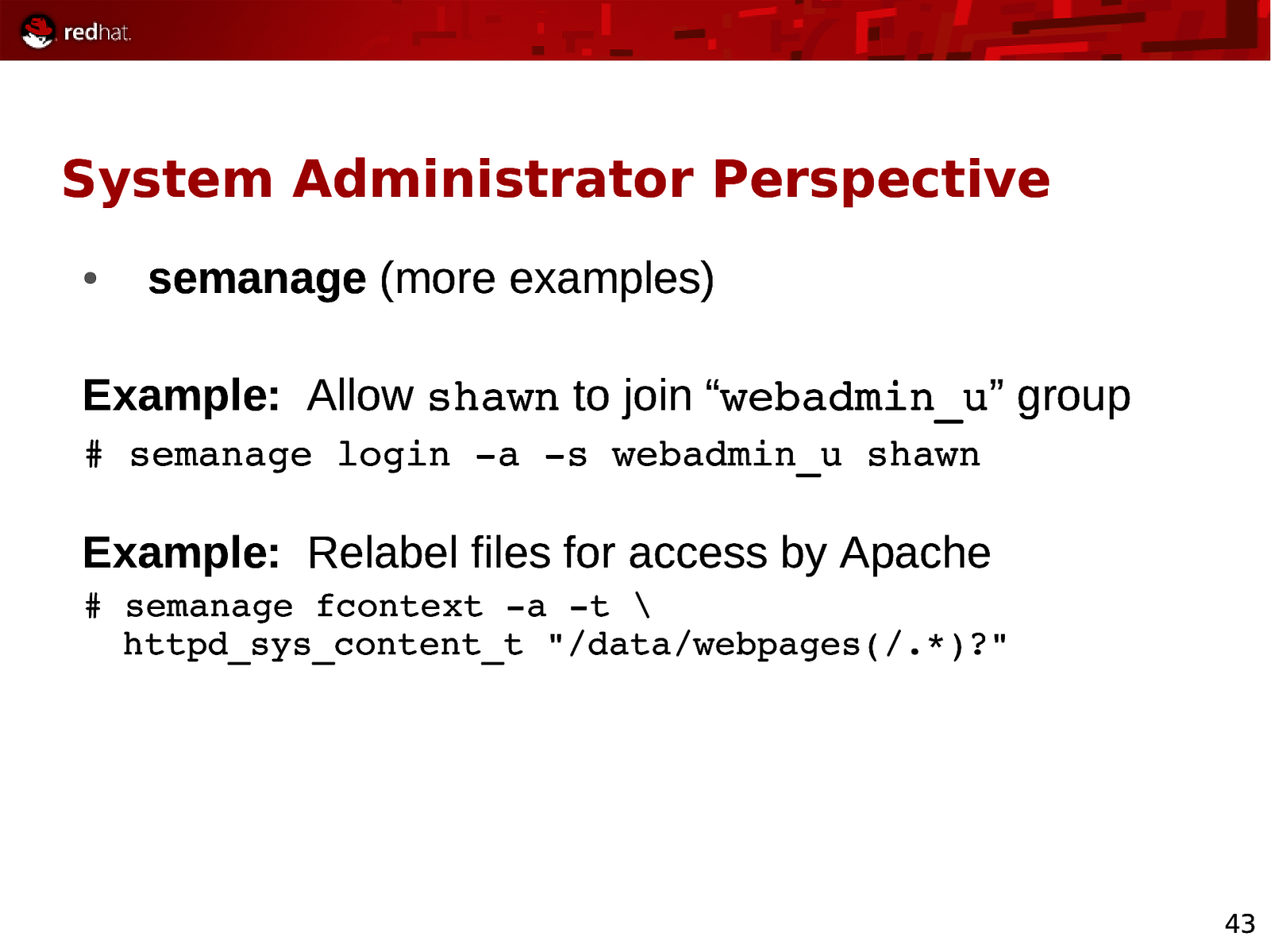
System Administrator Perspective ● semanage (more examples) Example: Allow shawn to join “webadmin_u” group # semanage login a s webadmin_u shawn Example: Relabel files for access by Apache # semanage fcontext a t \ httpd_sys_content_t “/data/webpages(/.*)?” 43
Slide 44

System Administrator Perspective ● semanage (most important example) You don’t need to disable SELinux to fix a single error! type=SYSCALL msg=audit(1204719775.306:738): arch=40000003 syscall=54 success=no exit=19 a0=4 a1=8933 a2=bfcec1bc a3=bfcec1bc items=0 ppid=3900 pid=5003 auid=501 uid=0 gid=0 euid=0 suid=0 fsuid=0 egid=0 sgid=0 fsgid=0 tty=(none) comm=”ip” exe=”/sbin/ip” subj=user_u:system_r:ifconfig_t:s0 key=(null) The Fix: # semanage permissive a ifconfig_t 44
Slide 45

System Administrator Perspective ● audit2allow Allows generation of SELinux policy rules from logs of denied operations Example: Fix all the errors on the system (completely not a good idea on a real system)
cat /var/log/audit/audit.log | audit2allow M FixAll Generating type enforcment file: FixAll.te Compiling policy: checkmodule M m o FixAll.mod FixAll.te Building package: semodule_package o FixAll.pp m FixAll.mod
semodule i FixAll.pp
45
Slide 46

Name of Presentation Red Hat Presenter Scenarios
Slide 47

Scenario: Fixing the RHT corporate VPN “update” ● Red Hat has a Corporate Standard Build (CSB) for desktop environments ● Red Hat pushes updates to said CSB ● I “tweak” my configuration files ● When RHT pushed a CSB update, it broke my VPN settings 47
Slide 48

Scenario: Fixing the RHT corporate VPN “update” /var/log/messages: type=SYSCALL msg=audit(1204719775.306:738): arch=40000003 syscall=54 success=no exit=19 a0=4 a1=8933 a2=bfcec1bc a3=bfcec1bc items=0 ppid=3900 pid=5003 auid=501 uid=0 gid=0 euid=0 suid=0 fsuid=0 egid=0 sgid=0 fsgid=0 tty=(none) comm=”ip” exe=”/sbin/ip” subj=user_u:system_r:ifconfig_t:s0 key=(null) Now what? 48
Slide 49

Scenario: Fixing the RHT corporate VPN “update” type=SYSCALL msg=audit(1204719775.306:738): arch=40000003 syscall=54 success=no exit=19 a0=4 a1=8933 a2=bfcec1bc a3=bfcec1bc items=0 ppid=3900 pid=5003 auid=501 uid=0 sgid=0 fsgid=0 tty=(none) comm=”ip” gid=0 euid=0 suid=0 fsuid=0 egid=0 exe=”/sbin/ip” subj=user_u:system_r:ifconfig_t:s0 key=(null) What I Know: 1) 2) 3) AVC Event ID 738 syscall=54 (I’d have to google this) root (or an application on its behalf) was running /sbin/ip 4) context = user_u:system_r:ifconfig_t:s0 49
Slide 50

Scenario: Fixing the RHT corporate VPN “update” type=SYSCALL msg=audit(1204719775.306:738): arch=40000003 syscall=54 success=no exit=19 a0=4 a1=8933 a2=bfcec1bc a3=bfcec1bc items=0 ppid=3900 pid=5003 auid=501 uid=0 sgid=0 fsgid=0 tty=(none) comm=”ip” gid=0 euid=0 suid=0 fsuid=0 egid=0 exe=”/sbin/ip” subj=user_u:system_r:ifconfig_t:s0 key=(null) My Options: 1) Create a SELinux Policy Module # ausearch x “/sbin/ip” | audit2allow M MyVPNFix 50
Slide 51

Scenario: Fixing the RHT corporate VPN “update” type=SYSCALL msg=audit(1204719775.306:738): arch=40000003 syscall=54 success=no exit=19 a0=4 a1=8933 a2=bfcec1bc a3=bfcec1bc items=0 ppid=3900 pid=5003 auid=501 uid=0 sgid=0 fsgid=0 tty=(none) comm=”ip” gid=0 euid=0 suid=0 fsuid=0 egid=0 exe=”/sbin/ip” subj=user_u:system_r:ifconfig_t:s0 key=(null) My Options: 1) Create a SELinux Policy Module # ausearch x “/sbin/ip” | audit2allow M MyVPNFix # semodule i MyVPNFix.pp 51
Slide 52

Scenario: Fixing the RHT corporate VPN “update” type=SYSCALL msg=audit(1204719775.306:738): arch=40000003 syscall=54 success=no exit=19 a0=4 a1=8933 a2=bfcec1bc a3=bfcec1bc items=0 ppid=3900 pid=5003 auid=501 uid=0 sgid=0 fsgid=0 tty=(none) comm=”ip” gid=0 euid=0 suid=0 fsuid=0 egid=0 exe=”/sbin/ip” subj=user_u:system_r:ifconfig_t:s0 key=(null) My Options: 2) Disable enforcement of ifconfig_t (there is no need to turn SELinux completely off!) # semanage permissive a ifconfig_t 52
Slide 53

Name of Presentation Red Hat Presenter Questions